Moissanite vs Diamonds: What Are The Differences?
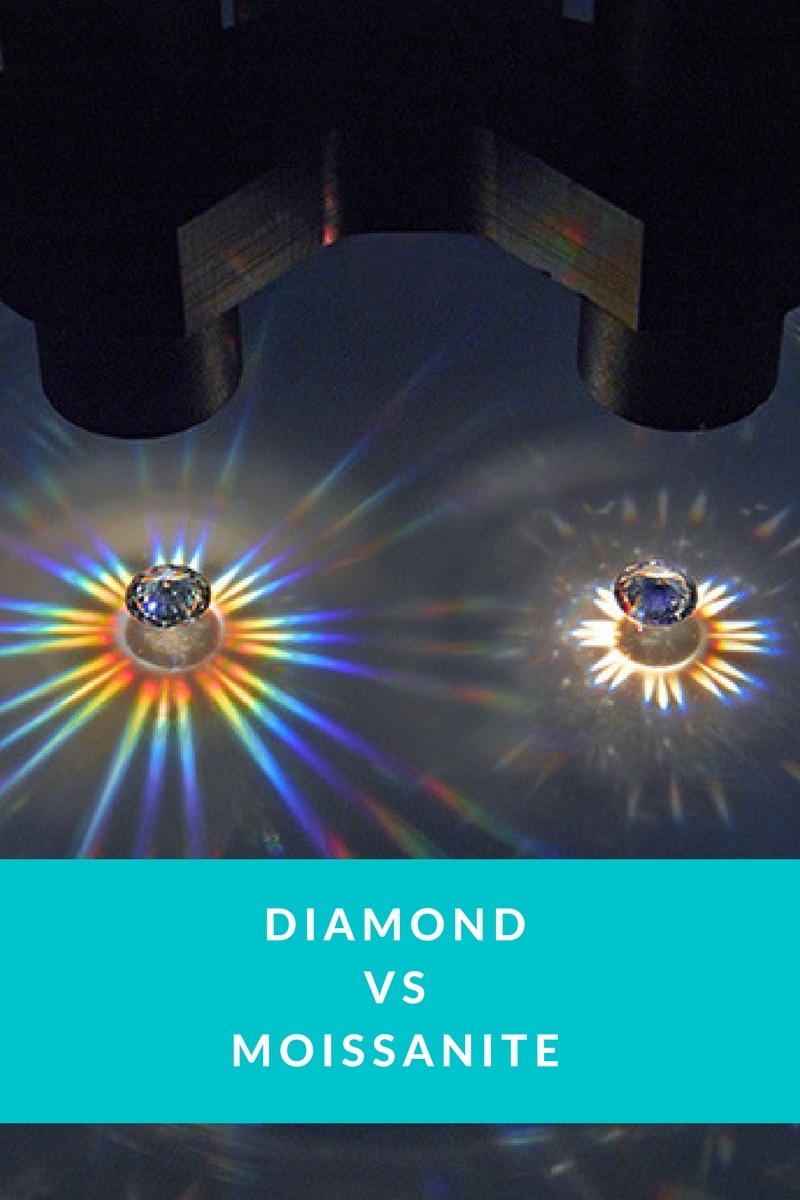
Diamonds have been a staple of engagement rings for decades, but alternatives like moissanite gemstones have seen rising popularity. Whether the reason is price, ethics, or simply breaking the norm, many newlyweds are taking the leap and opting for a non-traditional moissanite engagement ring.
But wait, what is moissanite?
Moissanite is a transparent, colorless gemstone made of silicon carbide that landed on Earth via meteorite centuries ago. As such, natural stones are incredibly rare, so almost all moissanites on the market are synthetic.
Why are people choosing moissanite engagement rings? The main reason is moissanite’s similarity to diamond for a much lower price. In fact, the first synthetic moissanite made in 1891 was created by accident while trying to make a synthetic diamond!
The big question is: is moissanite as good as a diamond? That’s what we’ll answer today, as we break down moissanite vs. diamond in terms of strength, beauty, price range, and ethical sourcing.
But first, let’s have a refresher on “synthetic” gemstones.
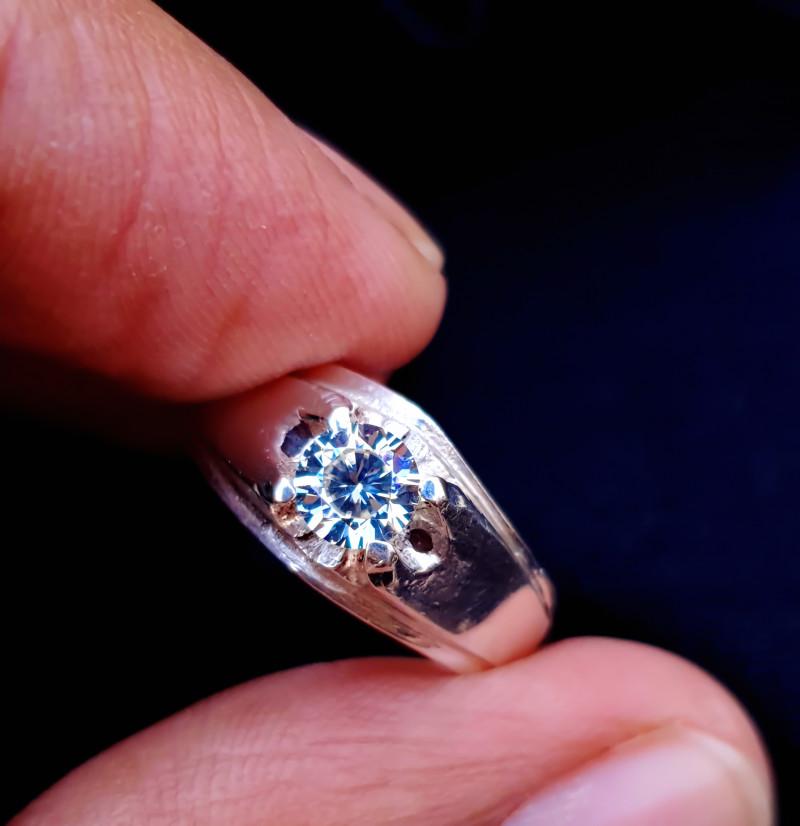
What Is a Synthetic Gemstone?
Terms like “synthetic,” “fake,” or “simulant” refer to gemstones that aren’t formed naturally, but these terms aren’t synonymous.
Synthetic gemstones, like synthetic diamonds or synthetic moissanites, are lab-created. They have the same chemical makeup and properties as their natural counterpart, but they’re man-made over a shorter time period. Other terms for “synthetic” include:
Man-made
Lab-grown
Created
Artificial
Simulant or imitation gemstones do not have the same properties as the natural gems they’re imitating. Cubic zirconia and moissanite can be diamond simulants, since they resemble natural diamonds but differ in chemical makeup.
With that out of the way, let’s get into the comparisons!
Moissanite vs. Diamond Strength
You want your wedding ring to last till death do you part… or ideally longer as an heirloom. That’s why durability is key! Durability is a combination of gemstone hardness, toughness, cleavage, and stability.
Hardness is a relative measure of a gem’s resistance to being scratched. You may know diamond is the hardest gemstone in the world, but do you know the second hardest gem? It’s moissanite!
At 9.25 - 9.5 on the Mohs mineral hardness scale, moissanite’s scratch resistance comes closest to diamond (at 10).
Besides scratches, you also have to worry about chipping and breaking. That’s where tenacity and cleavage come in.
Tenacity (or toughness) is a stone’s resistance to breaking or chipping. Cleavage describes how easily a gem will split along certain axes.
Diamonds have brittle tenacity and perfect cleavage (the easiest type to split) in 4 directions, meaning hitting it at any of these four angles would shatter the stone.
Meanwhile, moissanite is much tougher than diamond, with indistinct cleavage (a harder type to split) in 1 direction. Thus, moissanite is less prone to breakage than diamond.
Lastly, we have stability, which covers the conditions or chemicals that might damage a stone. Moissanites are extremely heat-resistant and require much higher temperatures to vaporize than diamonds do.
Sudden, intense temperature changes can make diamonds fracture, but not moissanite. Neither stone will react negatively to any chemicals.
The Impact of Cut on Durability
A gemstone’s cut can also affect its vulnerability to damage. Faceted shapes with sharp, pointed edges can chip from a hard blow. Common shapes in this category are pear, princess, trillion, and marquise, but custom fancy shapes with pointed edges can be just as vulnerable.
Shapes with rounded edges and no corners — round, oval, cushion — are less vulnerable to chipping. Round shapes are the most durable; plus, they’re the most common, offering a wide variety to choose from.
Let’s say you have your heart set on a princess-cut ring. You can still opt for this vulnerable cut and protect it from damage with the right protective setting.
Bezel, 6-prong, or claw settings are the safest for diamond or moissanite. Moissanite can withstand greater pressure than diamond, so tension settings are safe as a moissanite setting but not for diamonds.
Of course, cut also affects the overall appearance, which brings us to our next breakdown!
Moissanite Vs. Diamond: Comparing Appearance
One benefit of synthetic gems is greater control over their appearance. However, some traits are determined by the stone’s composition.
The first trait we’ll look at is color.
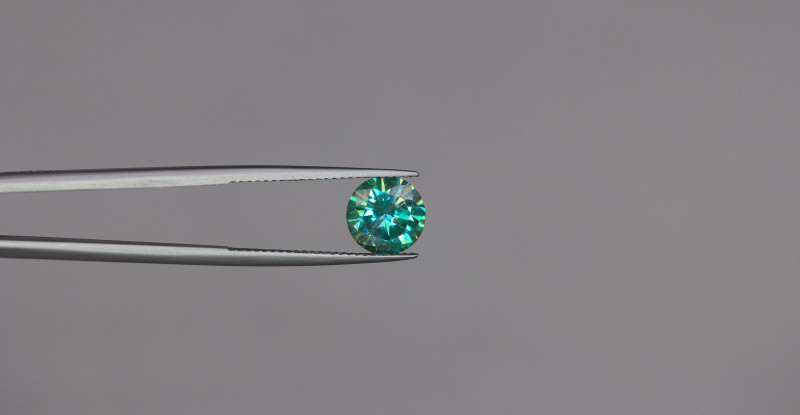 Image: green synthetic moissanite
Image: green synthetic moissanite
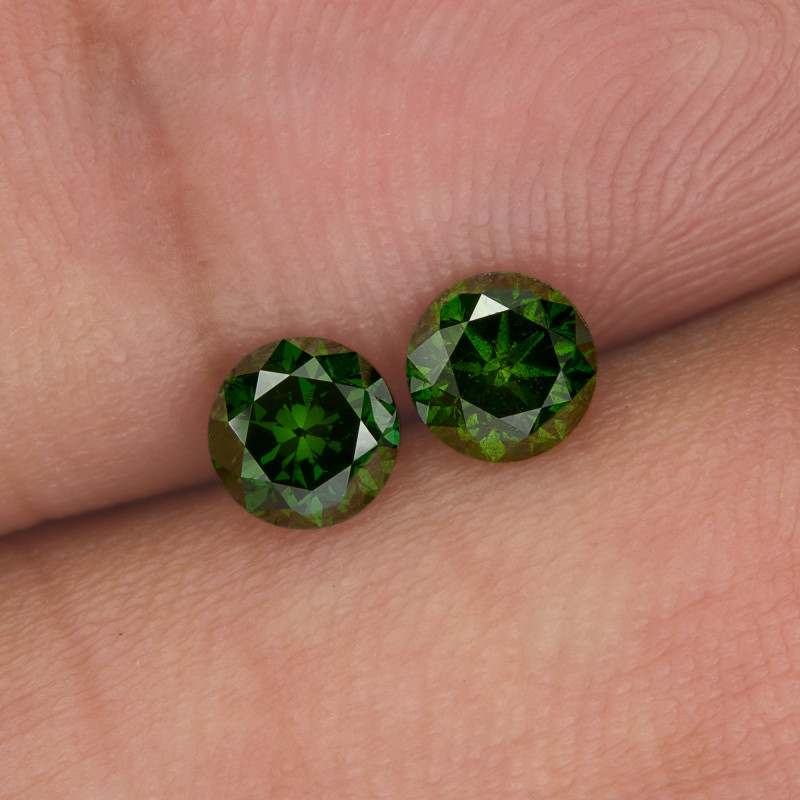 Image: deep green diamonds
Image: deep green diamonds
Color
Both moissanite and diamond are traditionally colorless. Both often have yellow to brown undertones. Treatments can remove those undertones if they’re too obvious.
Some buyers say their “colorless” moissanite appears slightly green or blue in natural lighting. We recommend always looking at the stone under multiple types of lighting before buying.
Do you prefer a colored gemstone engagement ring? Diamonds come in numerous shades, some produced by treatments. Moissanite treatments can produce shades like gold, blue, green, or pink, to name a few.
Colored diamonds, treated or untreated, will cost much more than colored moissanites. Still, the most colorless diamonds or moissanites will carry the highest value.
Clarity
Gemstone clarity measures the abundance and visibility of a stone’s inclusions. Moissanite’s clarity is based on diamond clarity grades. Each grade, starting with FL (Flawless) and going down to I3 (Included), will significantly influence price.
The synthetic moissanite production process has gotten better over time, so most moissanites on the market have excellent clarity. Natural diamonds with higher clarity are rarer and much pricier.
Will moissanite get cloudy over time? Nope! Any cloudiness showing up can be resolved with cleaning.
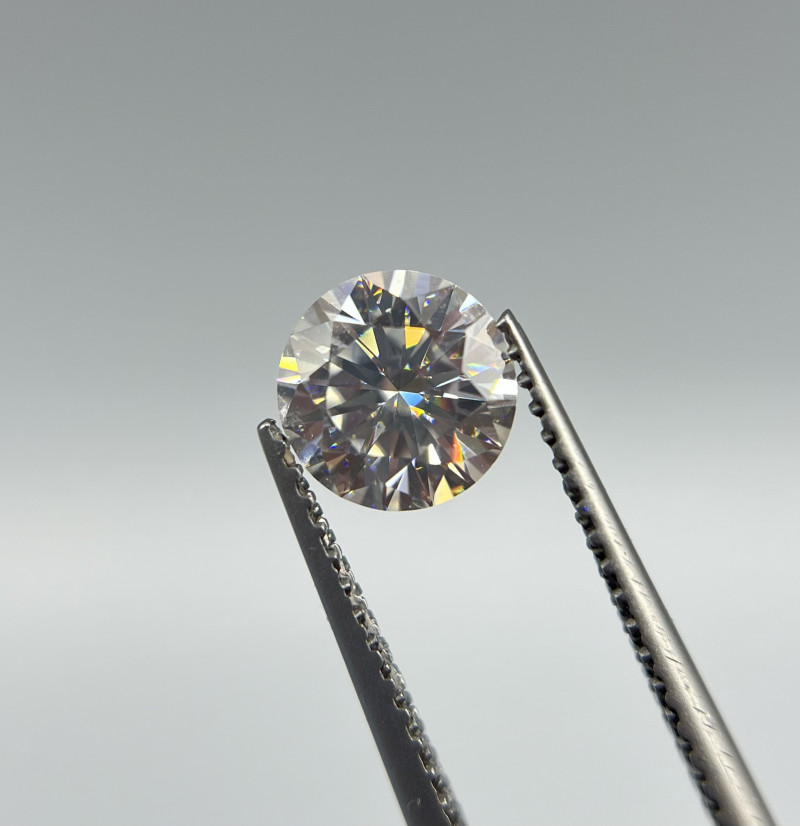 Image: white moissanite gemstone
Image: white moissanite gemstone
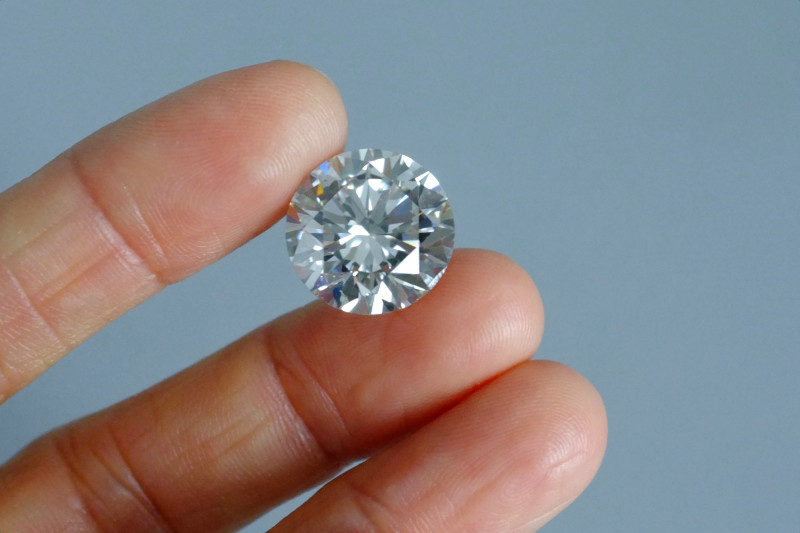 Image: white diamond gemstone
Image: white diamond gemstone
Brilliance & Fire (Sparkle)
Who doesn’t love admiring an engagement ring’s sparkle? The right cut is one factor for better sparkle — round brilliant being the best — but the stone’s dispersion and brilliance affect its glittering potential.
Dispersion, or fire, describes how much colorful light reflects from a gem. Diamond fire is 0.044, while moissanite fire is 0.104 — that’s over twice the fire of diamond!
Next, we have brilliance: the white light reflected from inside the stone, measured with the refractive index. A higher refractive index equals higher brilliance.
Moissanite’s refractive index is 2.59-2.69, while diamond’s is 2.41-2.42. The difference is slim but still means moissanite has a 10% greater brilliance than diamond.
Another property worth mentioning is birefringence, which occurs in gems with multiple refractive indices. Birefringence, or double-refraction, is when multiple rays of light reflect in different directions. This trait can allow stones to be pleochroic, displaying different colors from different viewing angles.
Diamonds are not birefringent (doubly-refractive), but moissanites are. Moissanite birefringence is 0.043.
In summary, moissanite has greater fire, brilliance, and birefringence than diamond.
You may know the 4 Cs of diamond quality (Color, Cut, Clarity, and Carat weight) and we’ve discussed a few so far. Next, we’ll discuss what many call the 5th C: Cost.
 Image: off-blue moissanite ring with cubic zirconia
Image: off-blue moissanite ring with cubic zirconia
Moissanite vs. Diamond Price
First and foremost, is diamond worth more than moissanite? Yes, diamonds fetch higher prices than moissanite.
But how much cheaper is moissanite than diamond? On average, moissanite price is about 10 percent of diamond price, all other factors being equal. That said, let’s examine those factors to see the real numbers.
Looking at carat weight, larger moissanites will be significantly lower in price than large diamonds. A round brilliant diamond with good clarity and decent color can be $7,000 to $51,000 per carat, though most are about $26,000. Meanwhile, a 3-carat moissanite with the same traits is around $3,000.
Still, most couples like 1-carat engagement rings. A near-colorless, round-cut, 1-carat diamond with good clarity will usually be $5,000 but can be $1,800 to $25,000. A 1-carat moissanite with the same traits is usually $300 but can be $450 to $600.
A 1-carat moissanite engagement ring with white gold and a VS1 to VS2 clarity, round-cut stone is typically around $1,400.
Important note: Moissanite is less dense than diamond, so it will be smaller (in mm) than a diamond of the same carat weight. Therefore, some sellers categorize moissanite by size rather than weight.
Another important note is that moissanite isn’t the most affordable diamond alternative. For instance, 1-carat cubic zirconia stones are only $20, though cubic zirconia doesn’t have moissanite’s sparkle or durability.
That covers the “5th C” of Cost, but there’s a 6th C that’s become more important than ever: Conscience, or “Conflict-Free.”
 Image: diamond rough
Image: diamond rough
Ethical Concerns and Sustainability
Decades ago, few people thought about where their diamonds came from. That changed after the 2006 docu-series Blood Diamonds, and the problem of conflict diamonds entered the public consciousness.
Conflict diamonds, or “blood diamonds,” come from war-torn areas and are sold to fund rebel militias trying to overthrow governments. Humanitarian issues like forced labor, child soldiers, and loss of life are tied to these diamonds.
The United Nations established the Kimberley Process in 2003 to address conflict diamonds through greater oversight and transparency about a diamond’s journey from mine to market.
Nations participating in the Kimberley Process must meet ethical sourcing criteria for their diamond importing and exporting, summarized in the diamond’s Kimberley Process Certification.
To do your part in ending conflict diamond trade when choosing diamonds, always look for a Kimberley Process Certification, plus records on the mine’s labor practices, supply-chain process, and sustainability efforts.
Another way to do your part is by opting for a synthetic stone!
Are Synthetic Stones More Ethical?
Sadly, even mines with the most ethical labor processes still make a negative impact on the environment and surrounding area. Synthetic gems have a significantly smaller environmental impact.
Synthetic gemstones eliminate issues like water contamination, pollution, and ecosystem destruction associated with mining.
The potential sustainability issue with creating synthetic gemstones, however, is energy emission.
Labs grow gems in mere weeks to months, significantly quicker than the millions of years for natural diamond growth. But, the machines involved require energy 24/7, so the type of energy used can tip the scales on sustainability.
Using renewable energy tips the sustainability scale in a lab’s favor. However, labs that use fossil-fuel energy can emit damaging carbon dioxide emissions.
Though, the lab's emissions are still 5.5-times less than those produced by even the most eco-conscious diamond mines, according to a 2020 Stanford comparison.
The choice with the least environmental impact is vintage or heirloom stones. If that’s not an option, synthetic moissanites are still significantly more ethical and sustainable than mined diamonds.
On the more metaphorical side, what does each ring mean?
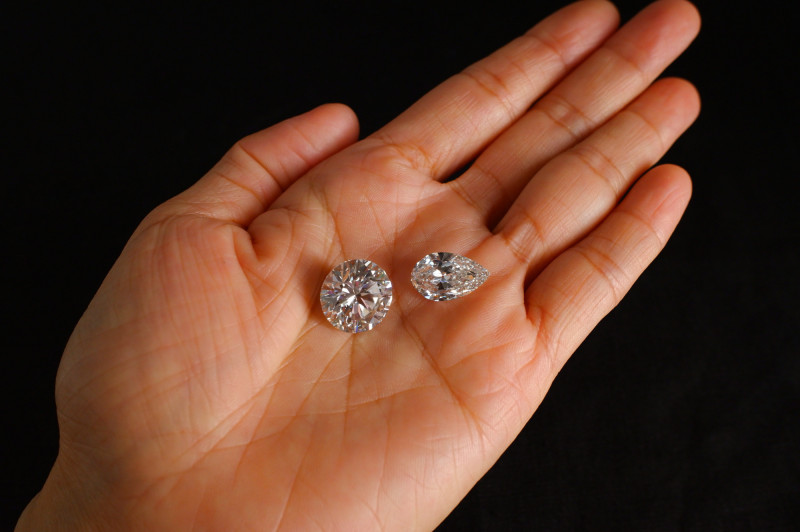 Image: diamond gemstones
Image: diamond gemstones
Diamond and Moissanite Ring Meanings
Diamond’s name comes from the Greek adamas, meaning “unbreakable.” This quality is both literal and figurative, as diamonds represent committed, enduring love.
What does moissanite mean? Moissanite rings similarly represent unbreakable love but also bring confidence, luck, and prosperity. They’re said to help you break from idle routines, making them perfect for any adventurous couple!
In terms of status, diamonds are still the highest symbols of luxury and prestige. That probably won’t change, though the importance of status seems to be shifting for some. Plus, the “tradition” of diamond engagement ring stones, and the false notion of their extreme rarity, only dates back to 1940s marketing.
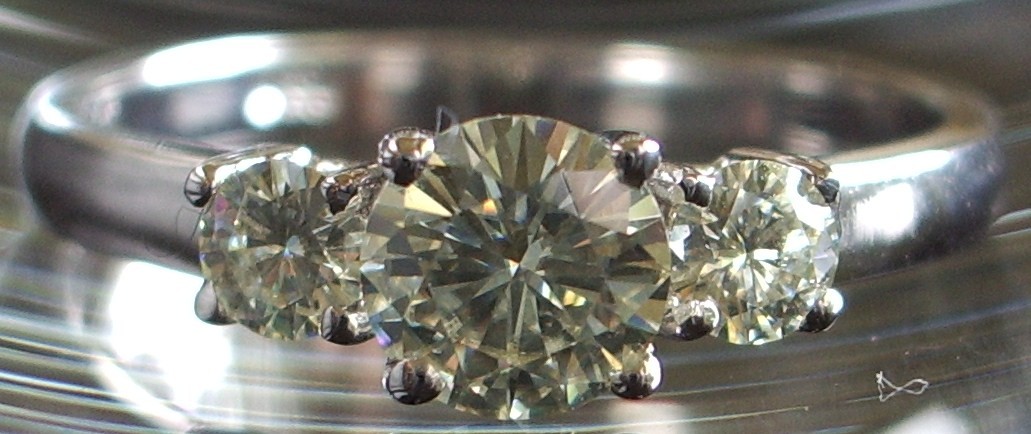
All Things Considered: Is Moissanite Worth Buying?
As the pièce de résistance of your engagement ring, the right gemstone makes all the difference. Given its extreme durability, beautiful appearance, and conscious creation, moissanite is certainly a worthy choice!
Of course, the best pick depends on your priorities. Want a natural stone? Diamond (or alternatives like morganite) may be your top pick. If you want the best bling for your buck, moissanite is the way to go.
Can’t decide? You can always get a moissanite and diamond engagement ring, or a diamond ring with a moissanite wedding band. Regardless of your pick, always do your research on the stone, seller, and source to shop confidently!
Still not sure? Explore our moissanite and diamond gemstone collections and see which stone you fall in love with!
Was this article helpful?
4 people found this article helpfulRoss Sedawie
- Written - 27th Nov 2017
- Edited - 1st Aug 2023
Comments

















